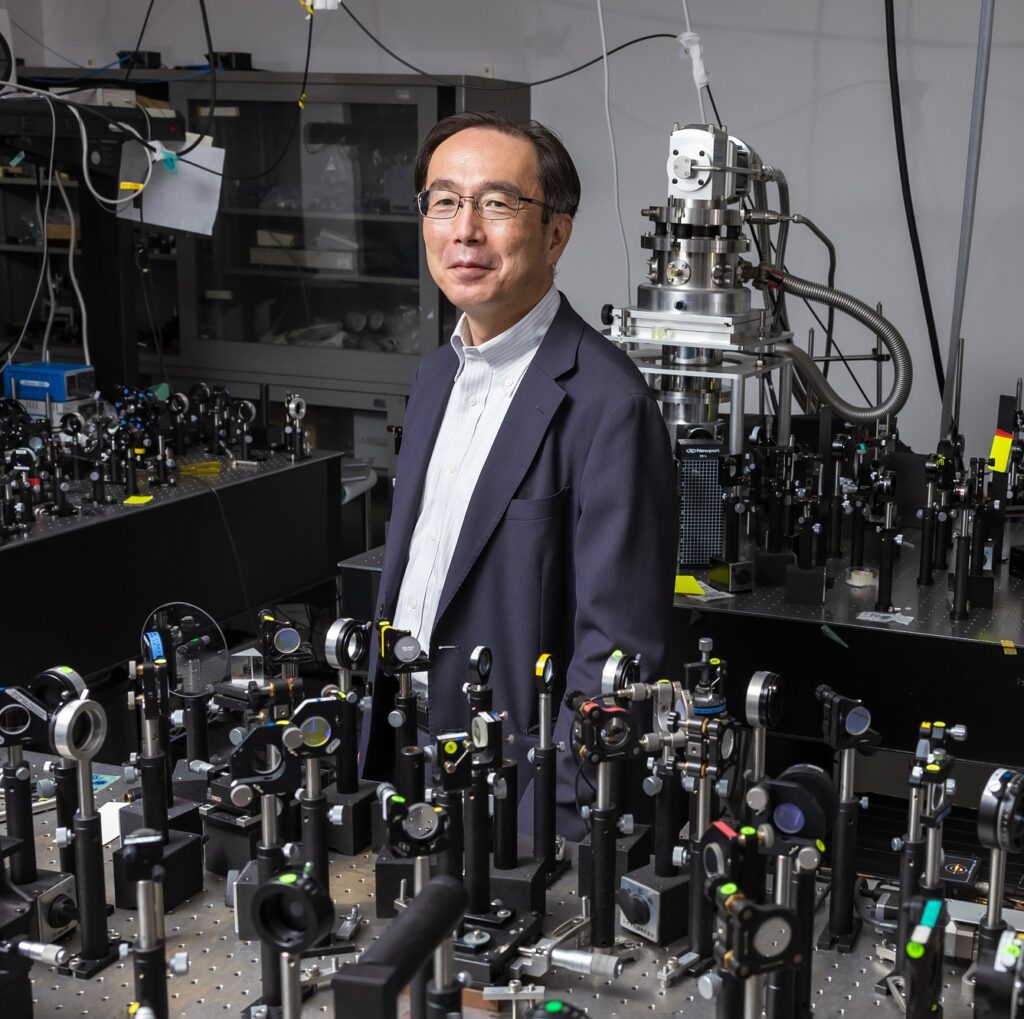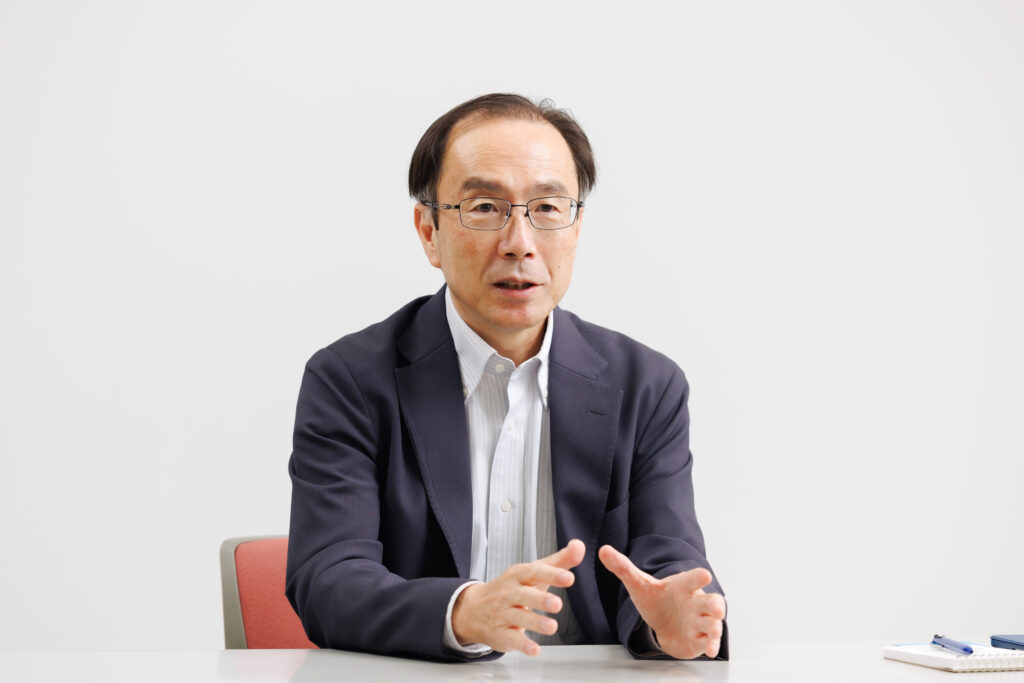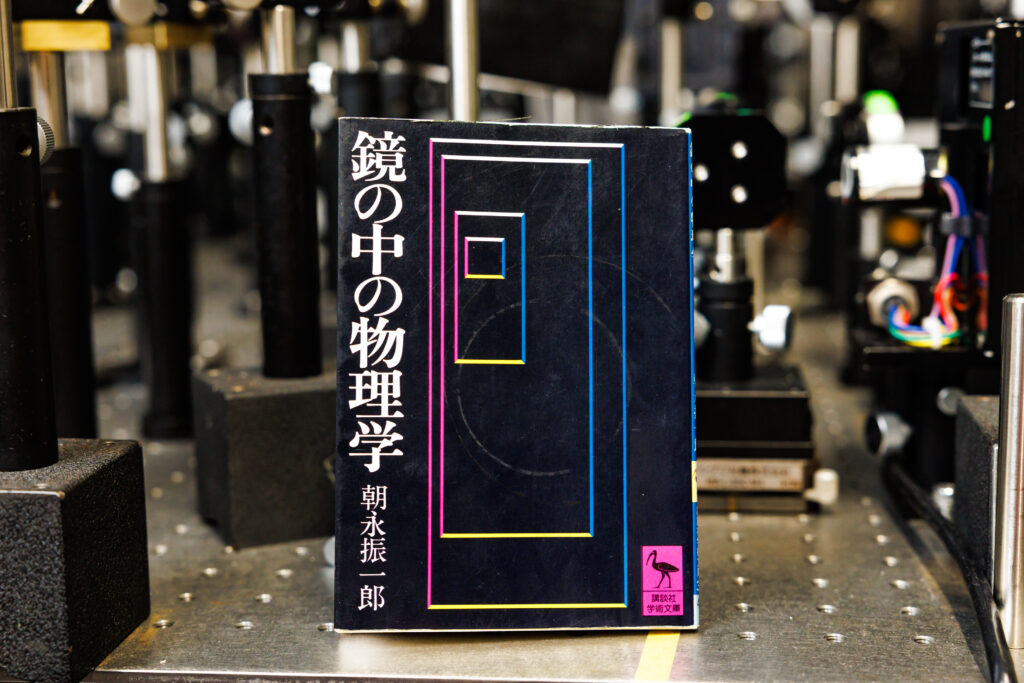
Professor Kazuhiro Ema of the Faculty of Science and Technology researches the interactions between light and various materials. Here, he discusses hybrid perovskites, a material that exhibits great promise for use in the next generation of solar cells, and joint development of sensors that use light to detect the presence of sugars and bacteria.
Light—from the sun, or from lighting that illuminates the darkness—is the fastest thing in the universe. It travels so quickly that it can circle the earth seven and a half times every second. On the other hand, when it strikes materials (water, air, and other substances), light reacts in various ways—it can be absorbed, scattered in all directions, reflected, or it can pass straight through. My research focuses on the physical interactions between light and materials—in other words, I investigate what happens when light strikes these materials.
In my research, I look at all manner of materials—semiconductors and organic materials, hybrid materials that are made by combining different substances, as well as molecules capable of detecting sugars and bacteria. Light has the property of a wave, and so its color and energy differ according to its wavelength. In my experiments, I use lasers to illuminate different objects for 100 quadrillionths of a second, and I observe the phenomena that occurs between the light and the materials, using a method akin to frame-by-frame playback.
Turning hybrid perovskites into solar cells

If we can understand the interactions between light and materials, we can develop new technologies that take advantage of the characteristics of these interactions. Semiconductor lasers, for example, can use the interactions between light and semiconductors to emit light of a desired wavelength, while optical communications can utilize the light-guiding property of glass fibers to realize high-speed communications.
I have been researching hybrid perovskites for more than 20 years, and development of perovskite solar cells is now accelerating at pace. Solar cells contain substances that generate electricity when struck by light, and this is how they convert light into electricity. Mainstream solar cells are typically made using silicon semiconductors, but perovskites have a high conversion efficiency comparable to silicon, yet they are also easier to manufacture; for these reasons, hopes are high that they can be affordably mass-produced.
I was initially interested in the dimensionality relationship between light and perovskites—dimensionality refers to confining the electrons within a substance in a two-dimensional surface, or in a one-dimensional line. When I first started my research, I was not thinking about possible applications in solar cells at all; however, the results of the research we undertook around 2000 caught the attention of a Japanese solar cell researcher, and in 2008 perovskite solar cells were announced for the first time. These are the circumstances under which our research has been recognized as a project that inspired the creation of perovskite solar cells.
Using light to detect water-borne bacteria in developing countries
I continue to research perovskites. At the same time, however, I am also engaged in researching light sensors that recognize sugars and bacteria. I experiment on various things and, as a consequence, colleagues from different fields often make suggestions as to what I might experiment on next. This, in fact, was how my research into sensors for sugars and bacteria started, and it is a field that has now been designated a priority research field by our university. The existence of molecules that emit light after capturing sugars and bacteria is well known; I am engaged in joint research with a number of fellow academics to use this knowledge to develop sensors capable of measuring sugars in the blood, and of detecting water-borne bacteria.
Sensors capable of detecting bacteria are a particularly pressing issue. Large numbers of people around the world do not have access to safely managed drinking water. If we can use light sensors to instantly assess the condition of bacteria inside a water source, we can determine whether it is safe to drink or not. One of the UN’s Sustainable Development Goals is to “ensure access to water and sanitation for all.” I hope to contribute to the realization of this goal with my colleagues.
The book I recommend
“Kagami no naka no butsurigaku”(The Physics Inside a Mirror)
by Shinichiro Tomonaga, Kodansha Gakujutsubunko

The author Shinichiro Tomonaga is a Nobel laureate in Physics, and in this book he explains fundamental physics in a humorous and easy-to-understand manner. In one of the three stories, which translates as “Photons on Trial,” he compares a photon—which is the smallest unit of light—to a robber that has broken in through the window. I guarantee you will enjoy this book, even if you know nothing about physics.
-
Kazuhiro Ema
- Professor
Department of Engineering and Applied Sciences
Faculty of Science and Technology
- Professor
-
Professor Kazuhiro Ema graduated from the Department of Applied Physics, School of Engineering, The University of Tokyo, completing his Master’s Degree in Applied Physics in 1985. In 1986, he withdrew from Ph.D. course to accept the position of Assistant Professor at Department of Applied Physics. In 1991, he received his Ph.D. in engineering from the same university. After working as a lecturer at The University of Tokyo’s School of Engineering, and as an assistant professor at the Faculty of Science and Technology, Sophia University, Ema was appointed to his current position in 2001.
- Department of Engineering and Applied Sciences
Interviewed: June 2022